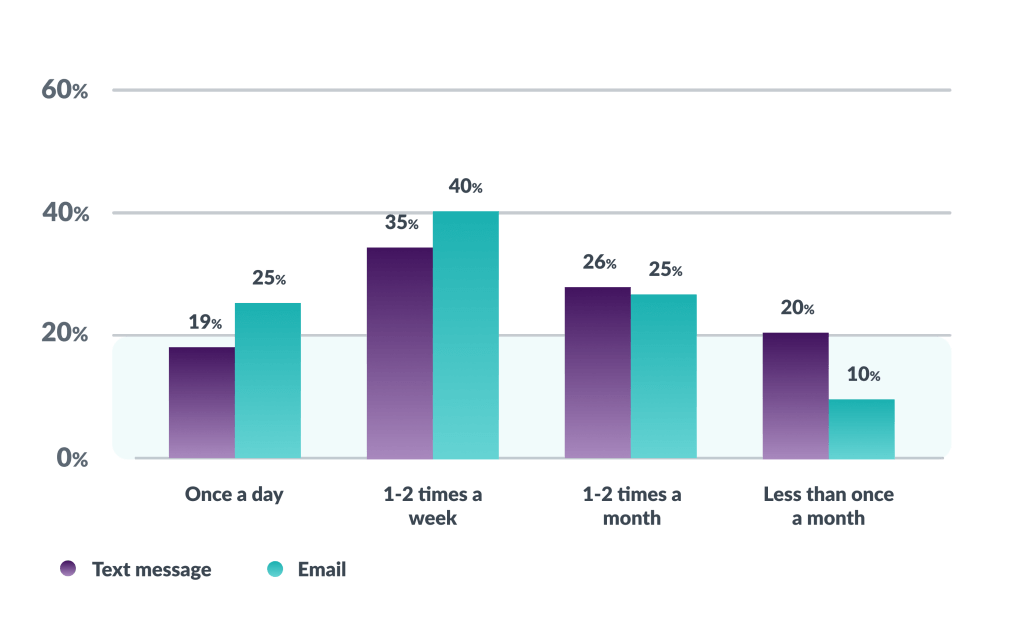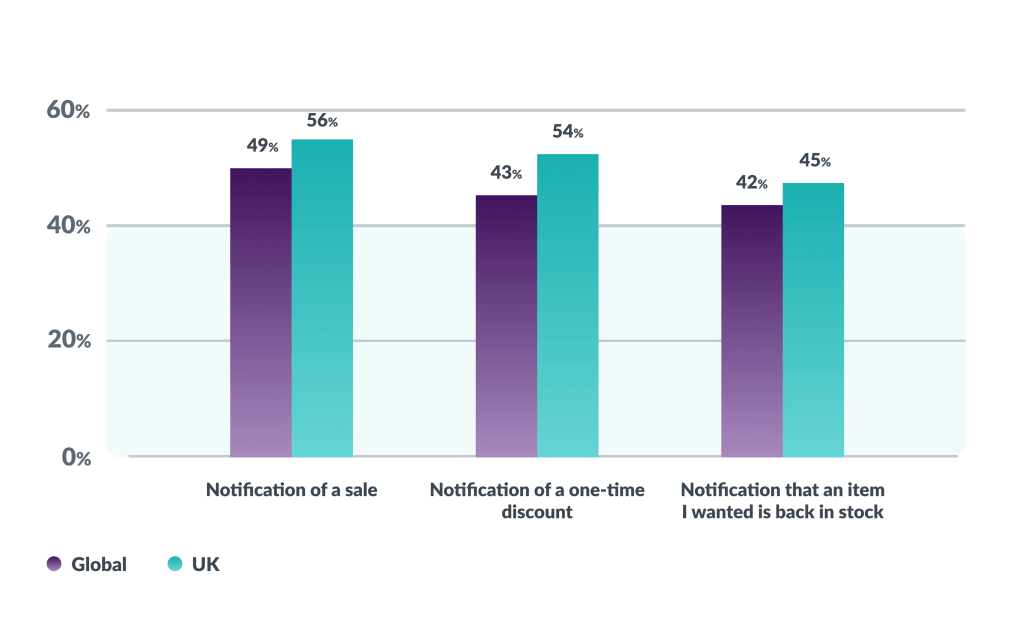
It’s one of the busiest shopping events of the year. We polled over 4,000 consumers globally to learn their digital shopping habits in preparation for Black Friday.
Black Friday is one of the biggest, if not the biggest, shopping events of the year. Although it originated in the US, Black Friday is slowly spreading to the rest of the world, let’s dive into some Black Friday statistics. Despite inflation and rising interest rates, ecommerce sales still reached $70.9 billion globally. In the UK, Black Friday sales increased by 7.3%, partially fuelled by consumers relying on promotions more than usual due to the cost of living crisis.
We conducted a survey to discover digital shopping habits across the UK, US, Spain, Australia, Italy, France and Germany. In this post, we’re highlighting some of the main Black Friday statistics to give you an idea of how your customers could behave this year.
- Most consumers will be reining in their spending so they can splurge in the Black Friday sales
- Over half of consumers would like to hear from businesses about Black Friday weeks in advance
- When it comes to receiving communications from brands, consumers are very open to text messages
- Though email remains dominant, don’t neglect SMS and WhatsApp
- Consumers are selective about how many brands they opt in to receive texts from
- Many consumers would consider being contacted about Black Friday via text or WhatsApp
- If signed up to receive emails or texts, consumers prefer to receive key information over anything else
- Marketing messages sent via text or WhatsApp can lead to a purchase
- Notifications of a sale, one-time discount or an item being back in stock are most likely going to catch customer attention
Most consumers will be reining in their spending so they can splurge in the Black Friday sales
According to many Black Friday statistics, in the lead-up to Black Friday, consumers typically rein in their spending so they’re ready to splurge in the sales. We found that 77% of consumers globally and 76% in the UK will stop shopping up to a month before Black Friday.
Globally, 10% of consumers will wait six weeks or more.
Over half of consumers would like to hear from businesses about Black Friday well in advance
As sale season approaches, businesses will want to let their customers know. But do customers want to hear about the latest sales, promotions and offers? Our Black Friday statistics show that the majority of consumers do!
Globally, of the 93% of consumers who do want to hear in advance about Black Friday, 83% are happy to hear up to four weeks in advance and more than half (53%) are happy to hear up to a fortnight in advance. In the UK, this figure is 56%, with a further 27% happy to receive promotional messages up to a month in advance.
When it comes to receiving communications from brands, consumers are very open to text messages
Email, social media and text messages are three of the top ways customers like to engage with their favourite brands.
But it’s not about sending generic sales and marketing messages. According to McKinsey’s Next in Personalisation 2021 Report, 71% of consumers expect personalisation and 76% become frustrated if they don’t find it.
Texts and emails are two of the easiest channels to personalise to the individual customer, thanks to features such as personalisation tokens. 35% of customers would be happy to receive texts 1-2 times a week and 39% would be happy to receive emails 1-2 times a week.
Though email remains dominant, don’t neglect SMS and WhatsApp
Email remains the dominant communication channel, with our research finding that customers are most likely to sign up to email newsletters, social media channels and SMS/text messages in that order.
Nearly half (48%) of those surveyed are signed up to receive newsletters from their favourite brands. 46% like to follow brands on Instagram, 39% on Facebook and 29% opt in to receive SMS/text messages. In the UK, the figures aren’t too dissimilar, with 51% signed up to a newsletter, 39% following them on Facebook and 24% signed up to receive text messages.
Customers also would prefer to receive emails more frequently than texts.
1 in 4 customers would be happy for businesses to email them once a day, compared to 19% for texts. And while 10% of customers would prefer to receive emails once a month, this figure is double (20%) for texts.
So, keep email as a staple in your communications stack. But don’t neglect platforms such as SMS/text and WhatsApp either as they are growing in popularity and give you an opportunity to cut through traffic and noise.

Stats from our 2022 Digital Shopping Habits survey
Consumers are selective about how many brands they opt in to receive texts from
Convincing consumers to opt in to receive text messages can be challenging. This makes sense, considering the personal nature of mobile messaging channels like SMS and WhatsApp. 59% of consumers say that they’re signed up to receive texts from up to six brands.
Some ways to collect opt-in include:
- An opt-in form on registration (e.g. at checkout, upon account signup etc)
- An email-based opt-in campaign
- A website pop-up
- Incorporated into your live chat and chatbot flow
Here are some tips on improving WhatsApp Business Platform opt-in and tips on improving SMS opt-in.
Many consumers would consider being contacted about Black Friday via text or WhatsApp
While email may still sit on the throne when it comes to customer communication, there are platforms on the rise that have huge, untapped potential.
Globally, 42% of consumers would opt-in to receive text or WhatsApp messages about Black Friday and other seasonal sales. The figure is similar in the UK, sitting at 43%.
If signed up to receive emails or texts, consumers prefer to receive key information above anything else
On the whole, if consumers are signed up to receive texts and/or emails from a business, they’d prefer to receive key, time-sensitive information. Delivery information and payment reminders are the two top messages globally while in the UK, consumers would prefer to receive via text or email.
Notifications of a sale, one-time discount or an item being back in stock are most likely going to catch customer attention
Social and mobile technology can not only amplify your marketing efforts, but it can also boost sales, particularly if you’re offering a sale or one off discount, or if you’re sending a back in stock alert.
81% of global consumers would consider purchasing a product from a business as a result of a marketing message received via text/SMS, or on Whatsapp. For the UK, the figure is 79%.
And in terms of the notifications that would encourage consumers to click on a link received from a business via text/SMS, or on Whatsapp, these are the top three:
- Notification of a sale
- Notification of a one-time discount
- Notification that an item is back in stock

Stats from our 2022 Digital Shopping Habits survey
What these Black Friday statistics mean for your business
1. Schedule your sale and promotion-related marketing materials in advance
Customers want to hear about upcoming sales and promotions in advance. Using the example of Black Friday where consumers rein in their spending prior to the date in order to really splurge, it’s worth sending them your offers so they can plan well in advance.
So, consider scheduling your marketing materials, whether that’s emails and texts to social media, at least two weeks in advance.
2. Use a mix of communication channels in your marketing strategy
Email, social media and SMS marketing should be core parts of your marketing strategy. Our research shows that email remains popular among customers, with nearly half (48%) signed up to a newsletter compared to 39% following their favourite brands on Facebook and 29% opting in to receive texts.
But that doesn’t mean email should sit front and centre in your marketing strategy. In fact, your campaigns stand the best chance of success when you incorporate a combination of channels, such as text, WhatsApp, email and social media.
3. Add WhatsApp to your list of communication channels
Connecting with customers via WhatsApp is becoming more popular. With more than two billion users globally, WhatsApp is one of the most used messaging apps. And as it turns out, customers want to engage with businesses via the same channel as they do for their family and friends.
Consider adding WhatsApp to your communication strategy if you haven’t already.
4. Be selective with what you choose to send on a regular basis
While customers would like to hear from businesses via text (over ⅓ even being happy to hear from them as often as 1-2 times a week), be selective with what you send them. Key information like delivery updates and payment reminders are what customers generally want to hear about if you’re going to be messaging them regularly.
5. Use SMS or WhatsApp to boost sales
Boosting email click-through rates is a challenge many marketers face. Encouraging customers to click on a link in a text might be even harder…unless you’re going to send targeted product links.
8 out of 10 customers would actually consider purchasing a product as a result of a marketing text or WhatsApp message. Particularly if the notification they received is one for a sale, a one-time discount or a back in stock alert. Give your customers an incentive to make a purchase and add the allure of “one-time-only”.
Businesses, are you ready for the Black Friday rush?
It’s one of the biggest and busiest shopping events of the year. Whether you’re participating online, offline or both, it’s time to start thinking about how your business will navigate Black Friday.
In our guide to Black Friday, we polled over 3,000 consumers globally and an additional 1,000 in the UK to discover their digital shopping habits. Condensed into a 12-page eBook, we break down the key statistics and give tips on how you can boost Black Friday sales and effectively create customer buzz. Download your copy here.
If you’d like even more expert insights, we held a webinar in association with one of the UK’s biggest ecommerce communities, IMRG. Hear from industry experts as they analyse the results from our latest global digital shopping habits survey and offer tips on how businesses can drive sales this Black Friday.
Learn more about the webinar and save your spot via the button below.



